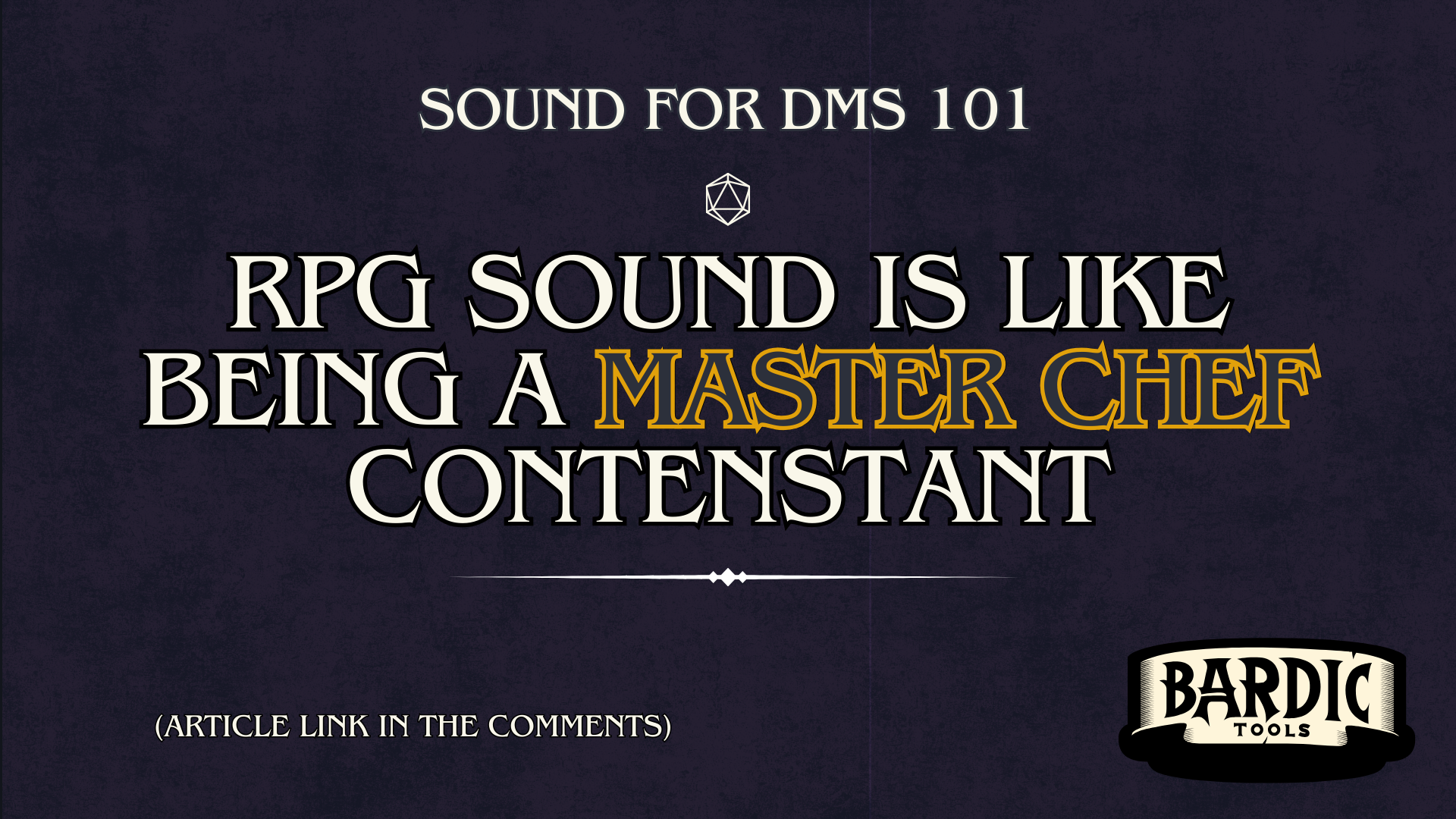Sound For DMs 101 - RPG Sound is Like Being a Master Chef Contestant

Hi!
I'm Borja, I've been DMing for 4 years, and in this series of articles I want to share the keys that have leveled up the sound in my games.
If you're a DM and are not sure how to introduce sound into your games, this article series is for you!
I'll be using Bardic Tools to demonstrate what I explain. That's why I built it, after all. To make great sound easy. However, these concepts should work with whatever you use for sound: A Spotify playlist, Syrinscape, Tabletop Audio, even a bunch of files in your laptop!
Without further ado, let's dive into it!
RPG Sound is Like Master Chef
No really, think about it.
In Master Chef (or any other cooking show), you have to:
- Think of what dishes you want to make.
- Gather all the ingredients ahead of time
- Cut, peel, portion, do as much prep as you can so that everything is at hand...
- ...but then you have to cook on the spot. Live. With an audience.
RPG sound is the same!
Don't believe me? Look!
- The dishes are scenes. "Think of the dishes you want to make" turns into "Think of the locations your players will go to, and how they should feel in each one".
- The ingredients are the sounds themselves. Gathering the ingredients becomes picking the sounds you'll likely use, so that they are at hand.
- Cutting, peeling, and portioning turns into arranging the sounds in a format where you'll be able to play them when you need them, without distracting you from the game.
- And last, cooking is running the session. The effect only comes together when you're playing. Live. With an audience.
This is powerful, because it gives us a step-by-step process to prepare impressive sound in our games. I'll summarize because it bears repeating:
- Think of the scenes we'll need,
- Select great sounds for them, and
- Arrange them in a way that will make running the session easy.
In this article and the next one in the series, I'll break down my process for each of these steps.
The Three Food Groups of RPG Sound
"Okay," I hear you say, "that's all great. But it's a bit vague, right? Easy to say that we select great sounds, but how do we know which sounds we need? Also, how are you so handsome and smart and good at coming up with great analogies?"
First, thank you.
Second, please allow me to continue with the Master Chef analogy a bit further. It's fun, trust me.
In a dish, you can have protein (or whatever main food you want), sauces, and garnish.
Turns out, sounds can be broken down in much the same way: Sound for a great scene is composed of music, ambience, and sound effects.
- Music is the protein, the main thing, the heavy-hitter. Music is usually a non-diegetic track that aims to put the players in a certain mood. Non-diegetic is a fancy term for "sound that your players hear but the characters don't". Think of The Nazgul Theme or Imperial March. Neither Frodo nor Luke (the characters) are actually hearing the march, but the audience (the players) sure are feeling it!
- Ambience is the sauce that binds everything together. It's the sound that will immerse players in the scene, that will communicate to them "yes, this is a very cold mountain", or "don't forget, there's a freakin' thunderstorm outside". Ambience is usually diegetic, which means that your players will hear what your characters are hearing. Therefore, great ambience makes players feel like their character feels.
- Sound Effects are the garnish, the little flourishes that are very hard to communicate with words. Allow me to illustrate. Consider the following text:
The ghouls have their back turned to you, too enthralled in their recent prey to notice. However, you know their hearing is acute. One misstep could spell doom for your party.
How much better does it get when you add this sound effect at the end of the description?
Of course, this can be a lot to prepare, and not every scene needs all three. If I didn't have time for everything, I'd prepare ambience before music, and music before sound effects. You can always use your mouth for sound effects in a pinch.
However, in following articles I'll give you tips and tricks on how to easily build up a library of sounds that will make preparation a breeze!
Or you can just use the pre-curated library at Bardic Tools, which already has plenty of hand-picked music, ambience, and sound effects ready to use.
Okay, we've seen the ingredients for a great scene. How do we make sure we can actually play them?
Prepare for Cooking
Now, we have ingredients. How do we arrange them in a way that will distract us the least during gameplay?
- For music, the ideal form is a playlist. You play one track at a time, with the next track ending as soon as the last one finishes. You never ever want two pieces of music playing at the same time, for reasons that we will explore in a following article.
- In Bardic Tools, you'd do this by dragging cards to the "Music Playlist" lane of a scene.
- Otherwise, you can use a playlist in whatever streaming service you fancy. I've used YouTube to great success, but Spotify is also a crowd favorite.
- I don't usually have more than 4 to 5 music tracks for a scene, as it's often better to have a single, awesome track on repeat than to have fifteen not-quite-stellar ones one after the others.
- Ambience tracks are natural sounds (like rain, or a campfire, or waves) that play in a loop and superimpose on each other.
- In Bardic Tools, you do this by dragging cards into the "Ambiences" lane in a scene.
- Otherwise, I'd strongly recommend finding a long video of the scene you want (for instance, "Campfire, 8 hours") on YouTube. There are plenty of ad-free videos made by very nice people that you can just leave in the background while you play.
- Having 5 or 10 handy ambiences that you toggle on and off will be enough to build a plethora of very immersive scenes (e.g. you could have rain by the campfire with the lakeside waves).
- Sound effects are usually played as a one-shot, at specific moments during the game. A single well-placed wolf howl, a surprising thunderclap are often all that's necessary to bring your players to the edge of their seats.
- In Bardic Tools, you guessed it, you get sound effects by dragging cards from the library into the sound effects lane of a scene.
- If you're not using Bardic Tools, I'd strongly recommend Tabletop Audio. It's free, and it has a lot of very cool sound effects.
- I usually prepare 15 to 20 sound effects for a scene. Since they don't have volume or looping settings, it's quite easy to find and play the right one in-game.
See it in action in this video:
In Conclusion
That's it for this article!
That was a lot of theory, so let's put it together into a checklist that you can copy and paste into your session templates:
- [ ] Think of the scenes we'll need,
- [ ] Select great sounds for them:
- [ ] 2-3 Music tracks that evoke strong feelings.
- [ ] 4-5 Ambience tracks that puts us in the skin of the characters.
- [ ] 3-5 Sound effects for garnish. I recommend having a thunderclap handy at all times.
- [ ] Arrange them:
- [ ] Make playlist for music.
- [ ] Pick 8-hour ambience video.
- [ ] Find a way to play sound effects.
In future articles, I'll explore things like how to pick the right music tracks for a scene, and how to use sound to make your villains unforgettable.
Until then, stay tuned!

